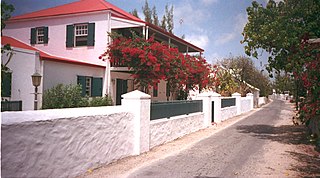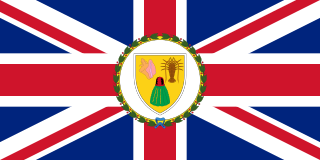
The Turks and Caicos Islands are a British Overseas Territory consisting of the larger Caicos Islands and smaller Turks Islands, two groups of tropical islands in the Lucayan Archipelago of the Atlantic Ocean and northern West Indies. They are known primarily for tourism and as an offshore financial centre. The resident population was 31,458 in 2012, of whom 23,769 lived on Providenciales in the Caicos Islands; July 2021 estimates put the population at 57,196. It is the third largest of the British overseas territories by population.

Before European colonization, the Turks and Caicos Islands were inhabited by Taino and Lucayan peoples. The first recorded European sighting of the islands now known as the Turks and Caicos occurred in 1512. In the subsequent centuries, the islands were claimed by several European powers with the British Empire eventually gaining control. For many years the islands were governed indirectly through Bermuda, the Bahamas, and Jamaica. When the Bahamas gained independence in 1973, the islands received their own governor, and have remained a separate autonomous British Overseas Territory since. In August 2009, the United Kingdom suspended the Turks and Caicos Islands' self-government following allegations of ministerial corruption. Home rule was restored in the islands after the November 2012 elections.

Cockburn Town is the capital of the Turks and Caicos Islands, spreading across most of Grand Turk Island. It was founded in 1681 by salt collectors. It is home to the Turks & Caicos National Museum which is believed to be over 180 years old. "Her Majesty's Prison", also now a museum, was built in the 1830s, and remained in operation until 1994. Boasting a warm climate all year round, the island is a popular tourist destination, with activities such as snorkeling, reef cruises, bars, and sandy beaches.

Politics of the Turks and Caicos Islands takes place in a framework of a parliamentary representative democratic dependency, whereby as of August 9, 2006 the Premier is the head of government, and of a multi-party system. The islands are an internally self-governing overseas territory of the United Kingdom. The United Nations Committee on Decolonization includes the Turks and Caicos Islands on the United Nations list of Non-Self-Governing Territories. Executive power is exercised by the government. Legislative power is vested in both the government and the Legislative Council.

The Governor of the Turks and Caicos Islands is the representative of the British monarch in the United Kingdom's British Overseas Territory of Turks and Caicos Islands. The Governor is appointed by the monarch on the advice of the British government. The role of the Governor is to act as the head of state and appointing the Premier and 5 members of the House of Assembly. The official residence of the Governor is Government House of Turks and Caicos Islands, Waterloo, Grand Turk.

The coat of arms of the Turks and Caicos Islands consists of a gold-coloured escutcheon (shield) charged with a conch shell, lobster and a cactus, supported by two flamingos, and topped with a pelican in the crest. Adopted three years after the islands became a Crown colony, it has been the coat of arms of the Turks and Caicos Islands since 1965. The escutcheon is featured on the flag of the territory. The previous badge featured two mounds of salt in front of a ship, with doors added to the mounds after they were reportedly mistaken for igloos.
Heroes' Day or National Heroes' Day may refer to a number of commemorations of national heroes in different countries and territories. It is often held on the birthday of a national hero or heroine, or the anniversary of their great deeds that made them heroes.
Arthur Christopher Watson, Watson was born in China, and educated at St Catharine's College, Cambridge. He was a British civil servant.
Alexander Graham Mitchell was the first Governor of the Turks and Caicos from April 1973 to May 1975. He had previously served as the last Administrator of the islands from 1971 to 1973. He went on to serve as Bursar of Dame Allan's Schools. Mitchell died in Corbridge, Northumberland, England in July 2010 at the age of 86.
Geoffrey Colin Guy CMG, CVO, OBE was the last Commissioner and the first Administrator of the Turks and Caicos from 1958 to 1959 and 1959 to 1965 respectively. Mr. Guy was succeeded by John Anthony Golding in 1965. He was administrator during Hurricane Donna, which in 1960 devastated agriculture on the island. He was managing director of the salt industry on the islands and used profits from the commodity to build airstrips and lay the foundation for today's main industry – tourism.
Administrator of the Turks and Caicos was the administrator of the Turks and Caicos from 1859 to 1973. It replaced the previous post of Commissioner of the Turks and Caicos and was replaced by the Governor of the Turks and Caicos after 1973.

The current flag of the Turks and Caicos Islands was adopted on 7 November 1968, and modified in 1999. Prior to this, the islands had several different flags either proposed or utilised.
Miss Turks and Caicos is a national Beauty pageant in Turks & Caicos.
Robert Wainwright may refer to:

The Anglican Diocese of the Bahamas and the Turks and Caicos Islands was originally established in 1861 as the Diocese of Nassau. Retitled the Diocese of Nassau and The Bahamas in 1942, it is now known as the Diocese of The Bahamas and the Turks and Caicos Islands. It is a diocese of the Church in the Province of the West Indies, a constituent province of the Anglican Communion.
Sonia Bien-Aime Fulford is a Turks and Caicos football administrator, the president of the Turks and Caicos Islands Football Association (TCIFA), a member of the FIFA Council, and the Executive Committee of CONCACAF.

The Real Housewives Ultimate Girls Trip is an American reality television series premiered on November 16, 2021 on Peacock. It follows several women from The Real Housewives franchise as they vacation together.






